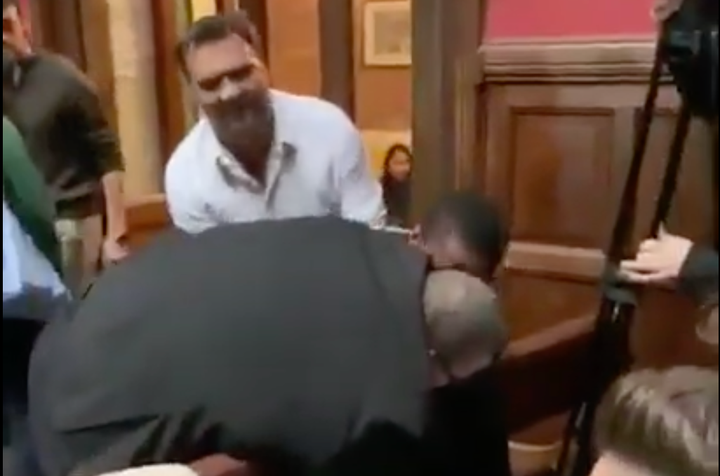The vast, echoey, wooden chamber of the Oxford Union Debating Society is no stranger to institutional racism. Its historical record has seen the presidency of Boris Johnson, of Jacob Rees-Mogg’s dad, and the hosting of speakers like Katie Hopkins, Nick Griffin and Marine Le Pen. Despite this less than desirable track record, many were nonetheless appalled and outraged last week when a more graphic form of racism, and ableism, took place at the debating society. As has emerged from eyewitness reports and shaky camera footage, postgraduate student Ebenezer Azamati, a visually impaired black student, was dragged out of the chamber by his ankles. The reason? Azamati had arrived early due to worries about accessibility requirements, left the chamber, and when he returned, was denied entry on the grounds that the chamber was allegedly full.
We still don’t know all the details of what happened, but misunderstanding or not, it’s outrageous that the incident escalated to the level that it did. The Union’s President Brendan McGrath has since resigned, citing it his “job to ensure that every member feels welcome at the Oxford Union”.
“For all of my shortcomings, and all of my mistakes, I apologise profusely and unqualifiedly,” he added.
But questions about the incident still abound. Why, upon sitting back down in a seat that was clearly empty, was Azamati told he must leave? Why were there so many members of security staff called to the scene? Did they understand that Azamati was visually impaired? Why did security lay their hands on him?

I personally do not know, but what I do know is that from my experience working on race and disability in higher education, and navigating archaic institutions as a black disabled student, I am shocked, but not surprised. During my time at Cambridge, where many of the institutional barriers are the same for black and disabled students, the institution frequently served to mistreat us in complex and myriad ways. Some will undoubtedly claim that Azamati’s case was a one-off – but it’s crucial to acknowledge that here we simply see the effects of racist and ableist exclusion at its most violent.
There is widespread evidence that black students, who make up only 2.6% of Oxford’s student body, are routinely physically excluded by the university. Students of colour at both Oxford and Cambridge frequently report being asked to show ID cards, or be refused college entry, when white students are not. There was widespread outrage in 2017 when a CCTV image of black graduate Femi Nylander was circulated in an internal email to all students of Harris Manchester College, warning them to be “vigilant”. And just weeks ago, one Oxford alumnus claimed that when he told a St. John’s porter he used to attend the college, the security member asked “what did you do, clean the windows? Rob it?” Whether implicit or explicit, violent or not, black students are accustomed to being told we don’t belong in “elite” spaces.
Looking outwards from Oxford and academia, we also know that it is not unusual for black people, particularly men, to be treated with excessive force – we have seen this time and time again in the viral videos associated with the Black Lives Matter movement. Although the connection might not seem immediately clear, it’s worth asking, would an older, white British academic have been treated the same as Azamati?
It’s also important to acknowledge what cases like Azamati’s can say about institutional ableism in archaic spaces like Oxford. Azamati arrived early to reserve an accessible seat – and when he returned to actually access it, he was violently removed. This speaks to wider issues around a lack of awareness of reasonable adjustments – it was his right to have that seat that best fit his requirements; and either due to a lack of adequate procedure or training, or perhaps a more general lack of education on disability, security staff didn’t understand this. Azamati’s case therefore shows the shocking and potentially violent outcomes when disability policy is not put in place, and when disabled students are treated as an afterthought.
Here was also see the failure to consider how traumatic a violent altercation might be for a student who is visually impaired. As Alun Peate, who is also visually impaired, told me: “It’s common knowledge in the blind community that we can get overwhelmed and distressed in unfamiliar surroundings, and by people we don’t know. When you can’t see and loads of folk are talking at you at once and people start pulling at you...you’re scared.” It is true that Azamati may not have known how many people were talking to him or manhandling him, making the use of violence all the more outrageous.
So what should Oxford do? The Union will certainly need to make concrete structural changes, that firstly, rule out the use of excessive force during altercations like the one we saw last week, and secondly, take account of the reasonable adjustments of disabled students. Many university (or in this case, student society) buildings physically exclude disabled students in the first place, so it is all the more crucial that there are policies in place for disabled students, which are widely disseminated to well-trained staff.
Secondly, the university itself needs to show some form of accountability. Oxford University condemned the incident in a Twitter statement, but also emphasised the Union’s autonomy from the central university last week. “The Union is an entirely independent club not governed by the University,” read one tweet. While it is true that the university and the Union (not to be confused with Oxford SU) might not be structurally linked, it’s impossible to ignore the cultural, historical and social connection between the two bodies. The majority of the society’s membership are Oxford students and alumni, and the prestige of the Union is undoubtedly due to its affiliation with the university. So, considering the university is usually happy to be associated with the Union all year round, it seems both convenient and cowardly that it chooses to labour the distinction during a PR crisis. Oxford must acknowledge that the structural and cultural climate of the Union is tied to that of the university, and push the Union for an apology, and concrete change.
Oxford concluded: “This student’s treatment goes against our culture of inclusivity and tolerance,” but looking at the history of racism and ableism within the University, we can say with certainty that this is not true. The Union, the University, and indeed higher education at large, need to address the way they approach both race and disability. If they do not, black and disabled students like Azamati will undoubtedly continue to suffer.
Micha Frazer-Carroll is opinions editor at gal-dem.

